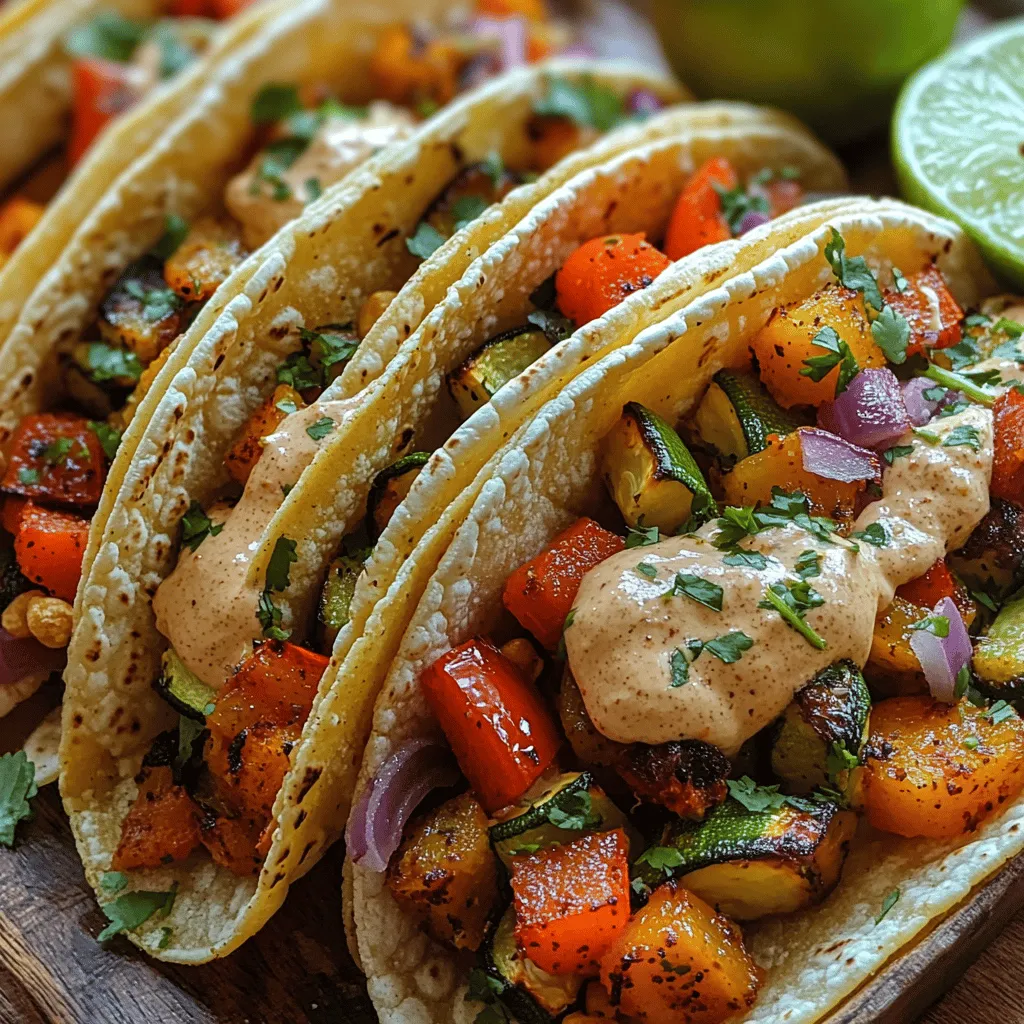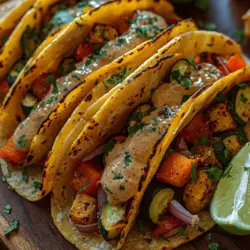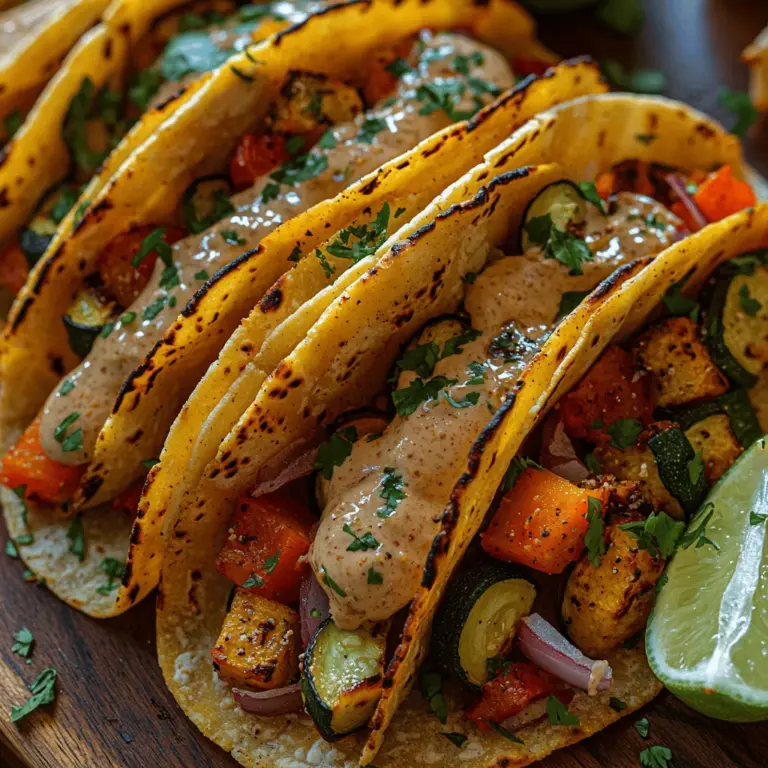Introduction
In recent years, vegan cuisine has surged in popularity, captivating the hearts and taste buds of food lovers around the world. With its emphasis on fresh, wholesome ingredients and innovative flavors, vegan cooking not only caters to those following a plant-based lifestyle but also attracts omnivores seeking healthier, more sustainable meal options. One dish that perfectly embodies this trend is Cashew Cream Vegan Tacos with Roasted Veggies. This recipe combines the rich, creamy texture of cashew-based sauce with an array of vibrant, roasted vegetables, making for a delicious and nutritious meal.
This dish offers a perfect blend of flavors and textures, featuring crispy roasted peppers, zucchini, and onion, all nestled in warm corn tortillas. The cashew cream adds a delightful richness that enhances the overall experience while keeping the dish entirely plant-based. Not only do these tacos satisfy your taste buds, but they also pack a nutritional punch, ensuring that every bite is as good for your body as it is for your palate.
Understanding Vegan Tacos
Vegan tacos are a delicious twist on the traditional taco, omitting animal products while still delivering on flavor and satisfaction. These plant-based tacos can be filled with a variety of ingredients, including beans, nuts, vegetables, and grains, making them incredibly versatile. The beauty of tacos lies in their adaptability; they can be customized to suit any dietary preference or taste profile, allowing for endless creative possibilities.
Choosing vegan tacos comes with numerous health benefits. They are typically lower in saturated fats and cholesterol compared to their meat-filled counterparts, making them a heart-healthy option. Incorporating more plant-based foods into your diet has also been linked to a reduced risk of chronic diseases, including heart disease, diabetes, and certain cancers. Furthermore, vegan tacos have a positive environmental impact, as plant-based diets require fewer resources and produce fewer greenhouse gas emissions compared to diets high in animal products. By opting for vegan tacos, you not only nourish your body but also contribute to a more sustainable future.
Ingredients Breakdown
To create these mouthwatering Cashew Cream Vegan Tacos with Roasted Veggies, you will need a selection of fresh and nutritious ingredients. Here’s a closer look at each component:
Corn Tortillas
Corn tortillas are a staple in Mexican cuisine and serve as the foundation for these vegan tacos. They are typically gluten-free, making them suitable for individuals with gluten sensitivities. Fresh corn tortillas offer a delightful texture and flavor that packaged versions may lack. However, if you’re short on time, high-quality packaged corn tortillas can still deliver excellent results. Look for options with minimal ingredients—preferably just corn, water, and salt.
Black Beans
Black beans are a fantastic source of plant-based protein and fiber, making them an essential ingredient in vegan tacos. With approximately 15 grams of protein and 15 grams of fiber per cup, they help keep you feeling full and satisfied. When using canned black beans, simply rinse them under cold water to reduce sodium content before adding them to your tacos. If you prefer, you can also cook dried black beans from scratch for enhanced flavor and texture.
Corn
Corn adds a natural sweetness and bright color to your vegan tacos. Whether you choose fresh, frozen, or canned corn, each option brings its own unique benefits. Fresh corn is at its peak flavor and nutrition when in season, but frozen corn is often picked and frozen at its prime, making it a convenient year-round option. Canned corn is also a viable choice; just be sure to drain and rinse it to remove excess sodium.
Bell Pepper, Zucchini, and Red Onion
The combination of bell peppers, zucchini, and red onion creates a colorful and flavorful filling for your tacos. Bell peppers are rich in vitamins A and C, while zucchini is a low-calorie vegetable that provides essential nutrients. Red onion adds a mild sweetness and crunch, balancing the flavors beautifully. Roasting these vegetables enhances their natural sweetness and adds depth to the dish.
Olive Oil
Olive oil is a healthy fat that serves as the base for roasting your vegetables. It contains monounsaturated fats, which are known for their heart-healthy properties. A drizzle of olive oil not only helps the vegetables caramelize in the oven but also contributes to the overall flavor of the tacos.
Spices: Smoked Paprika and Cumin
The spices you choose can elevate your tacos to a whole new level. Smoked paprika introduces a subtle smokiness that complements the roasted veggies perfectly, while cumin adds warmth and earthiness. Both spices offer additional health benefits, including anti-inflammatory properties and antioxidants.
Cashew Cream
One of the star components of this recipe is the cashew cream, which serves as a creamy sauce that ties all the ingredients together. Cashews are rich in healthy fats, vitamins, and minerals, making them a nutritious choice. Nutritional yeast can be added to the cashew cream for a cheesy flavor without the dairy, making it an ideal option for vegan cooking.
Creating the Cashew Cream
Cashew cream is a versatile ingredient in vegan cooking, providing a rich, creamy texture that can be used in various dishes, from sauces to desserts. Making cashew cream is simple and requires just a few steps.
Step-by-Step Guide on Preparing Cashew Cream
1. Soaking Cashews: Begin by soaking raw cashews in water for at least 4 hours or overnight. Soaking softens the nuts, making them easier to blend into a smooth cream. If you’re short on time, you can also soak them in hot water for 1-2 hours to achieve the same effect.
2. Draining and Rinsing: After soaking, drain the cashews and rinse them under cold water. This step helps remove any residual phytic acid, which can inhibit nutrient absorption.
3. Blending: Place the soaked cashews in a high-speed blender or food processor. Add fresh water, nutritional yeast (if using), and any additional seasonings, such as garlic powder or lemon juice, for flavor. Blend until the mixture is smooth and creamy, stopping occasionally to scrape down the sides. The goal is to achieve a velvety texture, so blend for several minutes as needed.
4. Adjusting Consistency: If your cashew cream is too thick, add a little more water until you reach your desired consistency. It should be thick yet pourable, perfect for drizzling over your tacos.
With these foundational elements in place, you’re ready to embark on the delicious journey of crafting Cashew Cream Vegan Tacos with Roasted Veggies. The next steps will guide you in assembling your tacos and roasting the vegetables to perfection, ensuring a delightful meal that showcases the vibrant flavors and health benefits of plant-based ingredients.

Variations and Substitutions for Cashew Cream
The cashew cream in these vegan tacos is a delightful and rich component, but you may want to explore variations or substitutions based on your dietary preferences or ingredient availability. Here are a few options:
1. Almond Cream: Almonds can easily replace cashews for a nutty cream that boasts a slightly different flavor profile. Soak almonds in water for several hours before blending with water, lemon juice, and seasonings.
2. Tofu Cream: For a lower-fat option, silken tofu can be blended to create a creamy texture. Add nutritional yeast, garlic powder, and lemon juice for extra flavor.
3. Coconut Cream: If you’re looking for a tropical twist, coconut cream can substitute for cashew cream. It adds a rich, slightly sweet flavor that pairs well with tacos.
4. Store-Bought Vegan Cream Cheese: Available at many grocery stores, this can be a quick and easy alternative. It will give you a similar creamy texture with a tangy taste.
5. Nut-Free Alternatives: If nuts are a concern, consider using sunflower seeds or hemp seeds. Both can be blended with water and lemon juice to create a creamy consistency without the allergens.
Roasting the Vegetables
The Art of Roasting: Why Roasting Enhances Flavor
Roasting vegetables brings out their natural sweetness and deepens their flavors. The high heat caramelizes the sugars, resulting in a deliciously complex taste that can elevate any dish. For these tacos, roasted veggies add a satisfying depth that complements the creamy cashew sauce and fresh toppings.
Step-by-Step Instructions for Roasting Vegetables
1. Preheat the Oven: Start by preheating your oven to 425°F (220°C). This temperature allows for optimal caramelization while ensuring the veggies retain a bit of crunch.
2. Prepare the Vegetables: Choose a mix of your favorite vegetables. Bell peppers, zucchini, red onion, and corn work beautifully. Wash and chop them into uniform pieces to ensure even cooking.
3. Season: In a large bowl, toss your chopped vegetables with a drizzle of olive oil, salt, and pepper. Feel free to get creative with spices—cumin, paprika, or chili powder can add a fantastic kick.
4. Spread on a Baking Sheet: Lay the seasoned vegetables in a single layer on a baking sheet lined with parchment paper. Ensure they aren’t overcrowded to allow for proper roasting.
5. Roast: Place the baking sheet in the oven and roast for about 20-25 minutes, stirring halfway through. The vegetables should be tender and caramelized when done.
Tips for Cutting and Preparing Veggies
– Uniformity is Key: Cut vegetables into similar-sized pieces to ensure they cook evenly.
– Use Fresh Produce: Fresh vegetables will not only taste better but will also roast more effectively.
– Don’t Overcrowd: If you have a lot of vegetables, consider roasting them in batches to prevent steaming.
Optimal Roasting Times and Temperatures
The 425°F (220°C) temperature is ideal for roasting most vegetables. Cooking times can vary based on the type and size of the vegetable:
– Bell Peppers: 20-25 minutes
– Zucchini: 15-20 minutes
– Red Onion: 20-30 minutes
– Corn (on the cob): 25-30 minutes
Flavor Pairing: How Spices Elevate Roasted Vegetables
Spices can dramatically enhance the flavor of roasted vegetables. Consider these combinations:
– Cumin and Coriander: Perfect for an earthy profile.
– Smoked Paprika: Adds depth and a hint of smokiness.
– Cayenne Pepper: For those who enjoy heat, a pinch can elevate the flavor significantly.
– Herbs: Fresh thyme or rosemary can be added during the last few minutes of roasting for a fragrant finish.
Assembling Your Tacos
Tips for Warming Corn Tortillas: Achieving the Perfect Texture
Warming corn tortillas is crucial for achieving the best texture and flavor. Here’s how to do it:
1. Stovetop Method: Heat a skillet over medium heat. Place each tortilla in the skillet for about 30 seconds on each side until warm and pliable. Avoid overcooking to prevent them from becoming crispy.
2. Oven Method: Wrap a stack of tortillas in aluminum foil and place them in a preheated oven (350°F/175°C) for about 10-15 minutes.
3. Microwave Method: Place a damp paper towel over a stack of tortillas on a microwave-safe plate and heat for 30-45 seconds.
Layering Ingredients: Best Practices for Taco Assembly
The way you layer your ingredients can influence the overall taste and enjoyment of your tacos. Follow these steps for optimal assembly:
1. Start with Tortillas: Lay your warmed tortilla flat on the plate.
2. Spread Cashew Cream: Use a generous amount of cashew cream as the base layer.
3. Add Roasted Veggies: Spoon the roasted veggies over the cream, distributing them evenly.
4. Top with Fresh Ingredients: Add toppings like diced tomatoes, avocado, or pickled onions for extra flavor and texture.
Customization Options: Adding Toppings and Variations
The beauty of tacos is their versatility. Here are some toppings to consider:
– Fresh Herbs: Chopped cilantro or parsley adds freshness.
– Salsas: A scoop of salsa can introduce additional flavors—try mango salsa or a spicy tomatillo salsa.
– Lime Juice: A squeeze of fresh lime juice brightens up the entire dish.
– Vegan Cheese: Consider adding shredded vegan cheese for an extra layer of creaminess.
– Hot Sauce: For those who love heat, a drizzle of your favorite hot sauce can elevate the flavors.
Garnishing and Serving Suggestions
Importance of Garnishes in Enhancing Presentation and Flavor
Garnishes are not just for looks—they can enhance both the presentation and flavor of your tacos. A sprinkle of fresh herbs or a drizzle of sauce can transform a simple dish into a culinary masterpiece.
Fresh Cilantro: Its Role in Mexican Cuisine
Cilantro is a quintessential ingredient in Mexican cuisine. Its bright, aromatic flavor complements many dishes, especially tacos. Be sure to chop fresh cilantro just before serving to maintain its vibrant flavor.
Serving Ideas: Pairing with Lime Wedges and Additional Sides
When serving your vegan tacos, consider these accompaniments:
– Lime Wedges: Offer lime wedges on the side for guests to squeeze over their tacos.
– Side Dishes: Pair with a refreshing side salad or Mexican-style rice and beans for a complete meal.
– Beverages: Complement with a light beverage such as agua fresca or a crisp margarita for a festive touch.
Nutritional Information
Overview of the Health Benefits of This Recipe
These cashew cream vegan tacos are not only delicious but also packed with nutritional benefits. They are rich in vitamins, minerals, and healthy fats, making them a wholesome option for any meal.
– Vitamins and Minerals: The variety of vegetables provides a range of vitamins like A, C, and K, while cashews offer magnesium and healthy fats.
– High in Fiber: This recipe is high in fiber, thanks to the vegetables and corn tortillas, promoting digestive health.
Breakdown of Macronutrients and Vitamins per Serving
While nutritional values can vary based on specific ingredients used, here’s a general breakdown per serving (two tacos):
– Calories: Approximately 350-400 kcal
– Protein: 10-12 grams
– Fat: 18-20 grams
– Carbohydrates: 40-45 grams
– Fiber: 7-10 grams
Comparison to Traditional Taco Recipes
Traditional tacos often include meat and cheese, which can be high in saturated fats and calories. In contrast, these vegan tacos offer a lighter, plant-based alternative that is equally satisfying without compromising on flavor.
Conclusion
Cooking vegan tacos is not just about the ingredients; it’s about the joy of creating a meal that is both healthy and delicious. The combination of creamy cashew sauce, roasted vegetables, and fresh toppings creates a symphony of flavors that can satisfy anyone, whether they follow a vegan diet or not.
This recipe is incredibly versatile, allowing you to experiment with different vegetables, sauces, and spices. The ease of preparation makes it an excellent choice for a quick weeknight meal or an impressive dish for entertaining friends.
As you venture into the world of plant-based cooking, remember that the kitchen is your playground. Embrace the creativity that comes with preparing meals at home, and don’t hesitate to explore new ingredients and techniques. Happy cooking!


